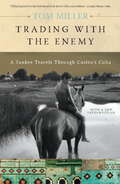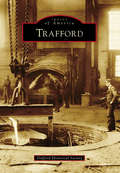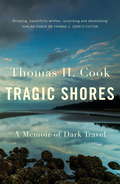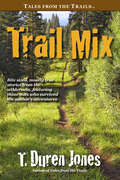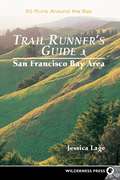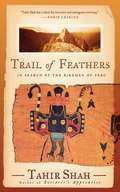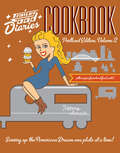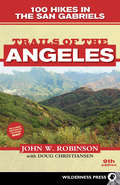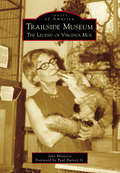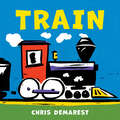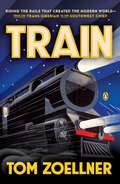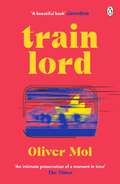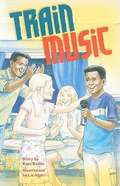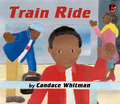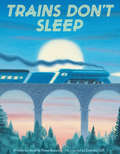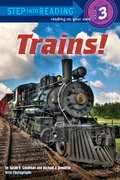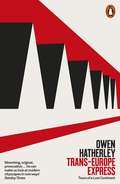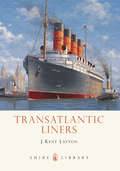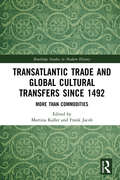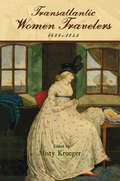- Table View
- List View
Trading with the Enemy: A Yankee Travels Through Castro's Cuba
by Tom Miller"Havana knew me by my shoes," begins Tom Miller's lively and entertaining account of his sojourn for more than eight months traveling through Cuba, mixing with its literati and black marketers, its cane cutters and cigar rollers. Granted unprecedented access to travel throughout the country, the author presents us with a rare insight into one of the world's only Communist countries. Its best-known personalities and ordinary citizens talk to him about the U.S. embargo and tell their favorite Fidel jokes as they stand in line for bread at the Socialism or Death Bakery. Miller provides a running commentary on Cuba's food shortages, exotic sensuality, and baseball addiction as he follows the scents of Graham Greene, José Marti, Ernest Hemingway, and the Mambo Kings. The result of this informed and adventurous journey is a vibrant, rhythmic portrait of a land and people too long shielded from American eyes.
Trafford (Images of America)
by Trafford Historical SocietyTrafford, located in the hills east of Pittsburgh, was officially incorporated as a borough in 1904. John Cavett I and his family were among the first settlers in the area, after purchasing land in 1769. Tracks for the Pennsylvania Railroad were laid through in 1852, and the territory became known as Stewart Station. In 1902, land at Stewart Station was purchased by renowned entrepreneur George Westinghouse, with the purpose of constructing a foundry and town to be named Trafford City, after Trafford Park in Manchester, England. Western Pennsylvania newspapers advertised the sale of lots in Trafford City, and thousands of property seekers came pouring in. The plant thrived for the majority of the 20th century and was the key to Trafford’s growth as a borough. Today, with the plant long gone, Trafford survives as a quaint, community-oriented town with an industrial history that all Pittsburghers can appreciate.
Tragic Shores: A Memoir of Dark Travel
by Thomas Cook'I have come to thank dark places for the light they bring to life.'Thomas Cook has always been drawn to dark places, for the powerful emotions they evoke and for what we can learn from them. These lessons are often unexpected and sometimes profoundly intimate, but they are never straightforward.With his wife and daughter, Cook travels across the globe in search of darkness - from Lourdes to Ghana, from San Francisco to Verdun, from the monumental, mechanised horror of Auschwitz to the intimate personal grief of a shrine to dead infants in Kamukura, Japan. Along the way he reflects on what these sites may teach us, not only about human history, but about our own personal histories.During the course of a lifetime of traveling to some of earth's most tragic shores, from the leper colony on Molokai to ground zero at Hiroshima, he finds not darkness alone, but a light that can illuminate the darkness within each of us. Written in vivid prose, this is at once a personal memoir of exploration (both external and internal), and a strangely heartening look at the radiance that may be found at the very heart of darkness.'A fascinating, troubling memoir from a fine writer' Mick Herron
Tragic Shores: A Memoir of Dark Travel
by Thomas Cook'I have come to thank dark places for the light they bring to life.'Thomas Cook has always been drawn to dark places, for the powerful emotions they evoke and for what we can learn from them. These lessons are often unexpected and sometimes profoundly intimate, but they are never straightforward.With his wife and daughter, Cook travels across the globe in search of darkness - from Lourdes to Ghana, from San Francisco to Verdun, from the monumental, mechanised horror of Auschwitz to the intimate personal grief of a shrine to dead infants in Kamukura, Japan. Along the way he reflects on what these sites may teach us, not only about human history, but about our own personal histories.During the course of a lifetime of traveling to some of earth's most tragic shores, from the leper colony on Molokai to ground zero at Hiroshima, he finds not darkness alone, but a light that can illuminate the darkness within each of us. Written in vivid prose, this is at once a personal memoir of exploration (both external and internal), and a strangely heartening look at the radiance that may be found at the very heart of darkness.'A fascinating, troubling memoir from a fine writer' Mick Herron
Trail Mix: Bite sized, mostly true stories from the wilderness, featuring those who survived the author's adventures
by T. Duren JonesGoing hiking? Don&’t forget to pack these bite-sized, mostly true stories from the wilderness, featuring those who survived the author&’s adventures. T. Duren Jones loves hiking wilderness trails. He gets out as often as he can, and enjoys taking friends and family on his explorations. Most of those who have joined his adventures still talk to him. He has hiked hundreds of trails in the American West, has summited all of the fifty-four Colorado 14,000 ft. peaks (now on his second round with his granddaughter), and has trekked the nearly 500 miles of the Colorado Trail&’s twenty-eight segments from Denver to Durango. Once he&’s done with one checklist, he on to the next—this guy is nuts! This book is a follow-up to Tales from the Trails, this time with new stories presented in bite-sized pieces. Snack on a few at a time, but you might not want to put it down and end up eating, er, reading, the whole package in one sitting. As with his previous book, Trail Mix is part adventure, part travelogue, part motivational encouragement, part cautionary tale, and part stand-up comedy (at least the author thinks so). Trail Mix is for anyone who loves spending time in the outdoors, who wishes they could be outdoors more, or who simply enjoys reading about nuts who spend time in the great outdoors. The author hopes by sharing these adventures—and misadventures—that the readers will be inspired to go out and discover their own stories.
Trail Runners Guide: San Francisco Bay Area
by Jessica Lage"Trail Runner's Guide: San Francisco Bay Area covers the best trail runs in the region's parklands and open spaces. This informative guide provides the detailed routes with descriptions of terrain, views, and vegetation from a runner's perspective. 50 featured routes, from 2 to 22 miles, plus alternative routes from every trailhead.Includes topographic maps with easy directions on facing pages, elevation profiles, and at-a-glance trail conditions and regulations for each run, plus equipment, safety, and running tips.
Trail of Feathers: In Search of the Birdmen of Peru
by Tahir ShahA shrunken head from Peru and a feather with traces of blood are the clues that launch Tahir Shah on his latest journey. Fascinated by the recurring theme of flight in Peruvian folklore, Shah sets out to discover whether the Incas really were able to "fly like birds" over the jungle, as a Spanish monk reported. Or were they drug-induced hallucinations? His journey, full of surreal experiences, takes him from the Andes Mountains to the desert and finally, in the company of a Vietnam vet, up the Amazon deep into the jungle to discover the secrets of the Shuar, a tribe of legendary savagery. Tahir Shah's flair for the unusual reveals Peru as we've never seen it. With his trademark humor, abundant curiosity, and oddball assortment of companions, he offers a journey that is no less illuminating than it is hilarious-and true.
Trailer Food Diaries Cookbook: Austin Edition, Volume 3 (American Palate)
by Tiffany HarelikIn the past few years, Austin has grown--and its appetite has kept up Tiffany Harelik, Austin's resident food truck ambassador and cookbook author, digs into her hometown's vibrant food truck scene for a third helping of local recipes. Meet the chefs behind the trucks and their sweet and savory specialties while gaining an insider's view of local recommendations. From basil spritzers and mint limeades to lomo saltado, chicken in mushroom-caper cream sauce and fried strawberries and everything in between, the recipes within are certain to inspire.
Trailer Food Diaries Cookbook: Portland Edition, Volume II (American Palate)
by Tiffany Harelik&“Profiles many of our most popular purveyors on wheels, and includes . . . recipes so cart-ivores can recreate their favorite dishes at home.&” —Mid-County Memo Portlanders have always had a taste for fresh local foods served up with a lack of pretense. So it&’s no surprise that food carts have emerged as a popular way to showcase a variety of flavors to hungry locals. While the business is a competitive one, the most unique and culturally diverse food trucks are able to thrive. From new spins on old classics—like the meatball sub and the spinach salad—to innovative creations like the Sriracha Mix-a-Lot and Peppered Peanut Popcorn Brittle, food carts have established a presence as culinary gems in a city brimming with creative dining options. Join Tiffany Harelik, author of the Trailer Food Diaries Cookbook series, as she returns to Portland to celebrate this growing food revolution.
Trails of the Angeles
by John W. Robinson Doug ChristiansenThe rugged San Gabriel Mountains, rising starkly from the edge of the Los Angeles Basin, provide a sharp contrast to the hustle and bustle of the city and its surroundings. Angelinos across the county (a population of almost 10 million), as well as visitors from out of state, welcome the opportunity to escape from city chaos into the quiet wilderness.This 9th edition of the classic Wilderness Press guide has been revised and updated to reflect recent trail changes, and now includes trips in the Fish Canyon Narrows, along Alder Creek, and to Jones Peak, as well as perennial favorites such as Old Baldy, Mt. Wilson, and Devils Punchbowl. Each detailed trip description notes the distance, difficulty, and ideal season, and points out the highlights of the trail. The guide includes a companion 4-color waterproof topo map.
Trailside Museum: The Legend of Virginia Moe
by Paul Harvey Jr. Jane MoroccoOn October 8, 1930, Charles "Cap" Sauers, general superintendent of the Cook County Forest Preserve District, wrote a letter to Alfred M. Bailey, director of the Chicago Academy of Sciences, about an idea he had. He proposed developing several nature study museums with the support of Bailey and the Academy of Sciences. Bailey eagerly wrote to Sauers that he had the Academy's full cooperation. By 1932, the Trailside Museum of Natural History was opened in River Forest, Illinois, the first of its kind in the Midwest. Several curators would come and go, but one in particular, Virginia Moe, dedicated more than 50 years of her life to the museum, animals, and people of Cook County. This is truly her story.
Train
by Chris DemarestIt&’s all aboard for baby&’s first train book! From the author of Plane, Bus, Ship, and Firefighters A to Z. Train chugs, Clickity-clack.Engine up front, Caboose in back. The amazing sights of a train ride through the countryside whiz by in this deceptively simple rhyming book. Little listeners will be mesmerized by this rhythmic, rhyming ride—perfect reading for kids on a roll! Praise for the books of Chris Demarest &“Creative texts and brightly colored images. The words, while spare, have been carefully chosen to create a level of anticipation and excitement for even the youngest of listeners.&”—School Library Journal on Train &“Demarest describes things seen and felt during a plane or ship ride, at the same time creating a pleasingly rhythmic, dreamy mood. Demarest&’s bold palette and unusually fluid lines lend a sophisticated, almost abstract air, furthering the impressionistic quality of the words . . . Very much a flight of fancy, this inventive melange of color, shapes and language may spur questions from youngsters beginning to wonder why the sky is blue, but the poetic trip launched here will let their imaginations soar.&”—Publishers Weekly on Plane and Ship
Train
by Elisha CooperA night train, a freight train, a high-speed train. Racing across the country, from coast to coast. All aboard! Climb aboard a red-striped Commuter Train in the East. Switch to a blue Passenger Train rolling through midwestern farmland. Then hop on a Freight Train, soar over mountains on an Overnight Train, and finish on a High-Speed Train as it races to the West Coast. Trains are moving. Fast and loud, colorful and powerful. Experience their sights, sounds, smells--and the engineers and conductors who make them go--as they roll across the country.
Train
by Tom ZoellnerA revelatory, entertaining account of the world's most indispensable mode of transportation Tom Zoellner loves trains with a ferocious passion. In his new book he chronicles the innovation and sociological impact of the railway technology that changed the world, and could very well change it again. From the frigid trans-Siberian railroad to the antiquated Indian Railways to the futuristic MagLev trains, Zoellner offers a stirring story of man's relationship with trains. Zoellner examines both the mechanics of the rails and their engines and how they helped societies evolve. Not only do trains transport people and goods in an efficient manner, but they also reduce pollution and dependency upon oil. Zoellner also considers America's culture of ambivalence to mass transit, using the perpetually stalled line between Los Angeles and San Francisco as a case study in bureaucracy and public indifference. Train presents both an entertaining history of railway travel around the world while offering a serious and impassioned case for the future of train travel.
Train
by Tom ZoellnerAn epic and revelatory narrative of the most important transportation technology of the modern worldIn his wide-ranging and entertaining new book, Tom Zoellner--coauthor of the New York Times-bestselling An Ordinary Man--travels the globe to tell the story of the sociological and economic impact of the railway technology that transformed the world--and could very well change it again. From the frigid trans-Siberian railroad to the antiquated Indian Railways to the Japanese-style bullet trains, Zoellner offers a stirring story of this most indispensable form of travel. A masterful narrative history, Train also explores the sleek elegance of railroads and their hypnotizing rhythms, and explains how locomotives became living symbols of sex, death, power, and romance.ed case for the future of train travel.
Train Lord: The Astonishing True Story of One Man's Journey to Getting His Life Back On Track
by Oliver MolThe astonishing true story of trust, pain, becoming lost, and finding a way back to yourself despite it all'An intimate preservation of a moment in time, full of personality' THE TIMES__________Life is beautiful - even in the dark . . .Oliver Mol was happily drifting through his twenties when the migraine exploded in his head.Suddenly, he could barely function. He felt marooned. Nothing helped. Yet he was desperate to save himself.Then he found the trains. The job of train guard has intense moments of strict, regimented activity in between periods of calm serenity. It was just what Oliver needed. Not only could he do this, but also it might be a way out.Train Lord is the story of Oliver's extraordinary recovery. A journey back into the light . . .__________'Tender, vital and quietly hopeful: a tale of remaking' Guardian'Rude, raw, visceral, painful and wildly funny' Saga 'Intense and humble, Train Lord won my heart' Australian Book Review
Train Music (Rigby PM Plus Ruby (Levels 27-28), Fountas & Pinnell Select Collections Grade 3 Level P)
by Kaye BaillieMartin would do just about anything than speak in front of people. It's his biggest fear. He is so relieved when the school bell rings and he can forget about his class speech until next semester.While travelling on a train to the city for a vacation, Martin makes a new friend. Melina is fundraising for her deaf and blind school, and has organised a singing contest on the train. Martin really likes Melina, and doesn't want to hurt her feelings, but he just can't get up there and sing in front of all those people.
Train Ride
by Candace Whitman<p>An African American boy experiences the excitement of his very first train ride with his parents. <p>Guided Reading: C ; Interest Level: Grades 1 - 1; Reading Level: Grades 1 - 1 <p>Themes: Vehicles In Motion, Families, Childhood Experiences and Memories, African/African American Interest, Beginning Concepts, People In Motion
Trains Don't Sleep
by Andria Warmflash Rosenbaum Deirdre GillPuffing, chuffing, never yawning Climbing hills as day is dawning. Trains don’t sleep, they CLANG and HOOT Cross bridges and canyons, plow through snow, charge down mountains, and meander across fields filled with sheep. And when it is time to rest and dreams are just ahead, never fear—trains don’t sleep so that you can. With the feel of a classic and vivid artwork that captures the power and majesty of trains, this is a fast-paced rhyming ode to the locomotive.
Trains! (Step into Reading)
by Michael Doolittle Susan E GoodmanA Step 3 reader (Reading on Your Own) that introduces trains of all shapes and sizes doing what they do best: hauling freight, carrying passengers, and zooming at speeds close to 400 miles per hour! Readers will encounterthe Jacobite--a Scottish train that plays the Hogwarts Express in the Harry Potter films. They will learn about the great steam locomotives that crossed the United States, joining east and west in 1869. They will travel the world, visiting Japanese commuter trains so busy that men called "pushers" pack people in! And they will learn about the different technologies--steam, diesel, electric, and electromagneticthat continue to make trains such an important part of our modern world. Illustrated with full color and black & white photos.From the Trade Paperback edition.
Tranquila: A Doctor-Mom Attempts the Slow Life in Spain
by Amy BreenDrinking glasses of cava in the sunshine, indulging in delicious tapas, and learning Spanish with ease is what Amy Breen, a hard-charging physician and mother of three, expected of life in Spain. But when she and her young family move to Barcelona, the tranquilo lifestyle of their new country has other ideas for her.Join Amy and her family in their mishaps and adventures living in Barcelona and traveling throughout Europe, and watch as Amy—openly and with a self-deprecating humor—unfolds her struggles in her transition from a handle-it-all doctor and mother in the States to full-time parent who needs her kids to translate. The tranquilo way of life is Amy&’s adversary, and then teacher, in this humorous personal and family journey.
Trans-Europe Express: Tours of a Lost Continent
by Owen Hatherley'A scathing, lively and timely look at the "European city", from one of our most provocative voices on culture and architecture today' Owen JonesA searching, timely account of the condition of contemporary Europe, told through the landscapes of its citiesOver the past twenty years European cities have become the envy of the world: a Kraftwerk Utopia of historic centres, supermodernist concert halls, imaginative public spaces and futuristic egalitarian housing estates which, interconnected by high-speed trains traversing open borders, have a combination of order and pleasure which is exceptionally unusual elsewhere.In Trans-Europe Express, Owen Hatherley sets out to explore the European city across the entire continent, to see what exactly makes it so different to the Anglo-Saxon norm - the unplanned, car-centred, developer-oriented spaces common to the US, Ireland, UK and Australia. Attempting to define the European city, Hatherley finds a continent divided both within the EU and outside it. 'The latest heir to Ruskin.' - Boyd Tonkin, Independent 'Hatherley is the most informed, opinionated and acerbic guide you could wish for.' - Hugh Pearman, Sunday Times 'Can one talk yet of vintage Hatherley? Yes, one can. Here are all the properties that have made him one of the most distinctive writers in England - not just 'architectural writers', but writers full stop: acuity, contrariness, observational rigour, frankness and beautifully wrought prose.' - Jonathan Meades
Transatlantic Liners
by J. LaytonPrior to air travel there was only one way to cross the Atlantic: by ship. By the late nineteenth century, steam ships dominated the transatlantic passenger trade, growing exponentially in size as maritime technology improved and as more immigrants poured from Europe into the New World. As the liners got bigger, the scope for luxury increased, so that a substantial part of ships such as Titanic would be given over to sumptuous dining saloons, lounges, smoking rooms and even gymnasia for the most affluent passengers. Meanwhile, the bulk of passengers, the poor migrants with one-way tickets to America, were efficiently arranged in small cabins with bunks in the bows and stern of the ship. This book is an introduction to the age of the superliner, from 1900 to the modern day, exploring changes in the liner's design and role over a century that saw competition between shipping lines and between nations. The author describes the history and design of such great ships as Lusitania, Olympic, Imperator, Normandie, both queen Elizabeths, both queen Marys and, of course, the legendary Titanic. He tells the story of the heyday of the great liners before immigration to America was curtailed, the many races for the Blue Riband speed record, the experiences of rich and poor passengers, the role of the liners as troopships and hospital ships during the world wars, and the decline in the Atlantic trade after the 1960s, since when most passengers have travelled by air.
Transatlantic Trade and Global Cultural Transfers Since 1492: More than Commodities (Routledge Studies in Modern History)
by Frank Jacob Martina KallerAccess to new plants and consumer goods such as sugar, tobacco, and chocolate from the beginning of the sixteenth century onwards would massively change the way people lived, especially in how and what they consumed. While global markets were consequently formed and provided access to these new commodities that increasingly became important in the ‘Old World’, especially with regard to the establishment early modern consumer societies. This book brings together specialists from a range of historical fields to analyse the establishment of these commodity chains from the Americas to Europe as well as their cultural implications.
Transatlantic Women Travelers, 1688-1843 (Transits: Literature, Thought & Culture 1650-1850)
by Eve Tavor Bannet Victoria Barnett-Woods Ula Lukszo Klein Misty Krueger Diana Epelbaum Shelby Johnson Grace Gomashie Pam Perkins Jennifer Golightly Alexis McQuigge Octavia Cox Kathleen MorrisseyThis important new collection explores representations of late seventeenth- through mid-nineteenth-century transatlantic women travelers across a range of historical and literary works. While at one time transatlantic studies concentrated predominantly on men’s travels, this volume highlights the resilience of women who ventured voluntarily and by force across the Atlantic—some seeking mobility, adventure, knowledge, wealth, and freedom, and others surviving subjugation, capture, and enslavement. The essays gathered here concern themselves with the fictional and the historical, national and geographic location, racial and ethnic identities, and the configuration of the transatlantic world in increasingly taught texts such as The Female American and The Woman of Colour, as well as less familiar material such as Merian’s writing on the insects of Surinam and Falconbridge’s travels to Sierra Leone. Intersectional in its approach, and with an afterword by Eve Tavor Bannet, this essential collection will prove indispensable as it provides fresh new perspectives on transatlantic texts and women’s travel therein across the long eighteenth century.
